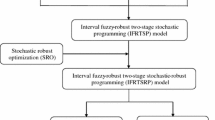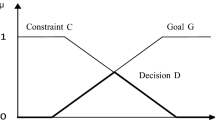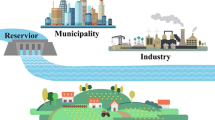Abstract
In this study, a fuzzy probability distribution- based multi-stage stochastic robust programming method has been developed for supporting regional water supply management. In the proposed model, methods of interval-parameter programming and robust stochastic optimization, and fuzzy probability distribution are introduced into a multi-stage stochastic programming framework, and the developed model can tackle uncertainties described in terms of interval values and fuzzy probability distributions. The developed model was applied to a water resources management system with three water users. A number of scenarios corresponding to different river inflow and α-cut levels are examined; the results suggest that reasonable solutions have been generated for regional water resources management. The results indicated that the optimization model’s outputs were highly dependent on the complex uncertain features of the study system, and the α-cut level of fuzzy probability had few significant impacts on the system objective. The results also implied that the developed method can be used for analyzing a variety of policy scenarios that are associated with different levels of economic consequences when the promised water-allocation targets are violated. Dynamics and uncertainties of water availability (and thus water allocation and shortage) could be taken into account through generation of a set of representative scenarios within a multistage context. The proposed method could be used by environmental managers to evaluate trade-offs of system benefits and risk involving fuzzy probability condition, as well as identify management solutions that sufficiently hedge against dual uncertainties.





Similar content being viewed by others
References
Andrieu L, Henrion R, Römisch W (2010) A model for dynamic chance constraints in hydro power reservoir management. Eur J Oper Res 207:579–589
Azaiez MN (2002) A model for conjunctive use of ground and surface water with opportunity costs. Eur J Oper Res 143:611–624
Bortolan G, Degani R (1985) A review of some methods for ranking fuzzy subsets. Fuzzy Sets Syst 15:1–19
Cai YP, Huang GH, Wang X, Li GC, Tan Q (2011) An inexact programming approach for supporting ecologically sustainable water supply with the consideration of uncertain water demand by ecosystems. Stoch Environ Res Risk Assess 25:721–735
David W, Watkins J, Daene CM, Leon SL, Soren SN, Quentin WM (2000) A scenario-based stochastic programming model for water supplies from the highland lakes. Int Trans Oper Res 7:211–230
Dong C, Huang GH, Cai YP (2012) An inexact optimization modeling approach for supporting energy systems planning and air pollution mitigation in Beijing city. Energy 37(1):673–688
Dupacová J, Gaivoronski A, Kos Z, Szantai T (1991) Stochastic programming in water management: a case study and a comparison of solution techniques. Eur J Oper Res 52:28–44
Ferrero RW, Riviera JF, Shahidehpour SM (1998) A dynamic programming two-stage algorithm for long-term hydrothermal scheduling of multireservoir systems. Trans Power Syst 13(4):1534–1540
He L, Huang GH (2008) Optimization of regional waste management systems based on inexact semi-infinite programming. Can J Civ Eng 35:987–998
Huang GH (1996) IPWM: an interval-parameter water quality management model. Eng Optim 26:79–103
Huang GH, Loucks DP (2000) An inexact two-stage stochastic programming model for water resources management under uncertainty. Civ Eng Environ Syst 17:95–118
Huang GH, Li YP, Xiao HN, Qin XS (2007) An inexact two-stage quadratic program for water resources planning. J Environ Inf 10(2):99–105
Jia YB, Culver TB (2006) Robust optimization for total maximum daily load allocations. Water Resour Res 42(2):W02412
Letcher RA, Croke BFW, Jakeman AJ (2007) Integrated assessment modelling for water resource allocation and management: a generalised conceptual framework. Environ Model Softw 22(5):733–742
Leung SCH, Tsang SOS, Ng WL, Wu Y (2007) A robust optimization model for multi-site production planning problem in an uncertain environment. Eur J Oper Res 181(1):224–238
Li YP, Huang GH, Nie SL (2006) An interval-parameter multi-stage stochastic programming model for water resources management under uncertainty. Adv Water Resour 29:776–789
Loucks DP, Stedinger JR, Haith DA (1981) Water resource systems planning and analysis. Prentice-Hall, Englewood Cliffs
Lu HW, Huang GH, Zeng GM (2008) An inexact two-stage fuzzy-stochastic programming model for water resources management. Water Resour Manag 22(8):991–1016
Maqsood I, Huang GH, Yeomans JS (2005) An interval-parameter fuzzy two-stage stochastic program for water resources management under uncertainty. Eur J Oper Res 167(1):208–225
Masatoshi S, Kosuke K, Hideki K (2004) An interactive fuzzy satisficing method for multi-objective linear programming problems with random variable coefficients through a probability maximization model. Fuzzy Sets Syst 146:205–220
Mobasheri F, Harboe RC (1970) A two-stage optimization model for design of a multipurpose reservoir. Water Resour Res 6:22–31
Mulvey JM, Vanderbei RJ, Zenios SJ (1995) Robust optimization of large-scale systems. Oper Res 43(2):264–281
Pereira MVF, Pinto LMVG (1985) Stochastic optimization of a multireservoir hydroelectric system: a decomposition approach. Water Resour Res 6:779–792
Qin XS (2012) Assessing environmental risks through fuzzy parameterized probabilistic analysis. Stoch Environ Res Risk Assess 26:43–58
Russell SO, Campbell PF (1996) Reservoir operating rules with fuzzy programming. ASCE J Water Resour Plan Manag 122:165–170
Tan Q, Huang GH, Wu CZ (2011a) IF-EM: an interval-parameter fuzzy linear programming model for environment-oriented evacuation planning under uncertainty. J Adv Transp 45(4):286–303
Tan Q, Huang GH, Cai YP (2011b) Radial-interval linear programming for environmental management under varied protection levels. J Air Waste Manag Assoc 60(9):1078–1093
Wagner HM (1975) Principles of operations research, 2nd edn. Prentice Hall, New Jersey
Wang XH, Du CM (2003) An internet based flood warning system. J Environ Inf 2:48–56
Wang S, Huang GH (2011) Interactive two-stage stochastic fuzzy programming for water resources management. J Environ Manage 92(8):1986–1995
Watkins DW, McKinney DC (1997) Finding robust solutions to water resources problems. J Water Resour Plan Manag ASCE 123(1):49–58
Xu Y, Huang GH, Qin XS (2009) An inexact two-stage stochastic robust optimization model for water sources management under uncertainty. Environ Eng Sci 26(12):1765–1776
Yager RR (1999) Decision making with fuzzy probability assessments. IEEE Trans Fuzzy Syst 7(4):462–467
Yager RR, Kreinovich V (1999) Decision making under interval probabilities. Int J Approximate Reasoning 22(3):195–215
Yu CS, Li HL (2000) A robust optimization model for stochastic logistic problems. Int J Prod Econ 64(1–3):385–397
Yu JJ, Qin XS, Larsen O (2013) Joint Monte Carlo and possibilistic simulation for flood damage assessment. Stoch Environ Res Risk Assess 27:725–735
Zeng Y, Cai YP, Huang GH (2011) A review on optimization modeling of energy systems planning and GHG emission mitigation under uncertainty. Energies 4(10):1624–1656
Zhou Y, Huang GH (2011) Factorial two-stage stochastic programming for water resources management. Stoch Environ Res Risk Assess 25:67–78
Acknowledgments
The article was supported by the Fundamental Research Funds for the Central Universities (No. FRF-SD-12-007B). The authors are extremely grateful to the editor and the anonymous editors and reviewers for their insightful comments and suggestions.
Author information
Authors and Affiliations
Corresponding author
Appendix
Appendix
t | Planning period | i | Water user, i = 1,2,3,4 for municipal, industrial, agricultural and eco-environmental sector |
k | Scenario of the happening of random events | h | Inflow level, h = 1,2,3 for low, medium, and high inflow level |
L t | Length of planning period (year) | \(W_{it}^{ \pm }\) | Water allocation target (106 m3) |
\(RW_{it}^{ \pm }\) | Reused water amount (106 m3) | \(NB_{it}^{ \pm }\) | Net benefit when water demand is satisfied ($/m3) |
\(\tilde{p}_{kt}\) | Fuzzy probability of available water resources | \(D_{ikt}^{ \pm }\) | water deficit amount (106 m3) |
\(C_{it}^{ \pm }\) | Penalty when water is not delivered ($/m3) | \(CR_{it}^{ \pm }\) | Cost for reused wastewater treatment ($/m3) |
\(\psi_{it}^{ \pm }\) | Water production amount of per fresh water consumption | \(WP_{th}^{ + }\) | Available water resources amount (106 m3) |
\(DW_{it}^{ \pm }\) | Water resources demand of each user (106 m3) | \(SWT_{t}^{ \pm }\) | Wastewater treatment capacity (106 m3) |
\(\xi_{it}^{ \pm }\) | Wastewater reuse rate | \(RWT_{it}^{ \pm }\) | Reused water treatment capacity (106 m3) |
\(\omega\) | Weight coefficient | \(\theta_{ikt}^{ \pm }\) | Slack variable |
α | α-cut level | \(d_{kt} ,\beta_{kt}^{ - } ,\beta_{kt}^{ + }\) | Triangular fuzzy numbers that is the fuzzy probability of occurrence |
Rights and permissions
About this article
Cite this article
Xie, Y.L., Xia, D.H., Huang, G.H. et al. A multistage stochastic robust optimization model with fuzzy probability distribution for water supply management under uncertainty. Stoch Environ Res Risk Assess 31, 125–143 (2017). https://doi.org/10.1007/s00477-015-1164-8
Published:
Issue Date:
DOI: https://doi.org/10.1007/s00477-015-1164-8




